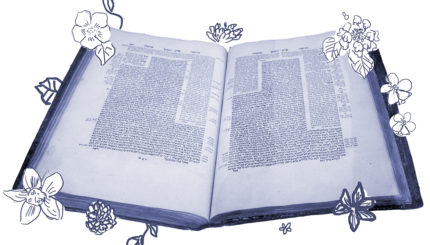In a mishnah on Bava Batra 108, we learned that a man can inherit from his mother.
Today, the Talmud explores where the mishnah got this idea.
“And every daughter who possesses an inheritance from the tribes of the children of Israel ” (Numbers 36:8). How can a daughter inherit from two tribes? Rather, this one whose father is from one tribe but her mother is from another tribe, and they died, and she inherited from both of them.
When the Torah sets out the laws of inheritance in Numbers 36, it explicitly accounts for the position of women. And the text seems to suggest that daughters have the potential to inherit from multiple tribes (note the plural) if her parents came from multiple tribes. The implication is that daughters can legally inherit from both their father and their mother. The Talmud then uses the case of daughters to extrapolate that sons also inherit from their mothers by means of a kal vachomer (a fortiori inference).
And just as a daughter, whose power is diminished with regard to her father’s property (in that she does not inherit it when there is a son), her power is enhanced with regard to her mother’s property (in that she inherits it), a son, whose power is enhanced with regard to his father’s property (because he inherits over daughters), is it not logical that his power is enhanced with regard to his mother’s property?
We can say a lot about the Bible’s approach to women’s rights to inheritance and to property in general. In the interest of space, I’ll simply note that biblical law does not map onto modern inheritance law, in which, if someone dies without a will, the property is divided equally between heirs regardless of their gender. And I will also note that the Mishnah and the Talmud both allow for deathbed gifts which do not follow the biblical laws of inheritance. So according to the rabbinic system, someone who wants their daughters to inherit even if they have sons can distribute their property on their deathbed however they choose. The laws under discussion on today’s daf only apply to whatever property remains after such a deathbed distribution.
But with all these caveats, the Talmud reasons that given that the biblical inheritance system privileges sons over daughters, if women have the right to inherit property from their mothers, surely men should also have that right.
The Talmud next examines whether men merely have the right to inherit from their mothers alongside their sisters, or if they have a privileged status such that only sons inherit from their mothers — and daughters only inherit if there are no sons.
Just as there (with regard to a father’s property) a son precedes a daughter, so too here (with regard to a mother’s property) a son precedes a daughter.
Perhaps a daughter only inherits from her mother if she has no brothers. Fascinatingly, this position reads a biblical statement about daughters to exclude daughters from the line of inheritance if there are sons. But the text continues:
Rabbi Yosei, son of Rabbi Yehuda, and Rabbi Elazar, son of Rabbi Yosei, said in the name of Rabbi Zekharya ben HaKatzav: Both the son and the daughter are equal with regard to the mother’s property. What is the reason? It is sufficient for the conclusion that emerges from an inference to be like its source.
According to Rabbi Zekharya ben HaKatzav, if the biblical source text is about women, then we can’t read women out of the line of inheritance. Therefore, both men and women inherit from their mothers equally.
The talmudic discussion is going to conclude by siding with the anonymous first voice, privileging sons over daughters even when it comes to maternal inheritances. And this conclusion is widely accepted in later rabbinic discourse. But reading the fullness of the rabbinic argument here reminds us that the laws of men’s inheritance are built on the experiences of women’s inheritance. Reading carefully and contextually makes visible the women who are too often invisible in Jewish law.
Read all of Bava Batra 111 on Sefaria.
This piece originally appeared in a My Jewish Learning Daf Yomi email newsletter sent on October 14, 2024. If you are interested in receiving the newsletter, sign up here.
With your help, My Jewish Learning can provide endless opportunities for learning, connection and discovery.



